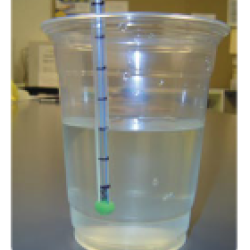Source Institutions
Source Institutions
Add to list Go to activity
Activity link broken? See if it's at the internet archive

In this activity, learners discuss the different salinities of oceans, rivers and estuaries. Learners then use experimentation to determine which sample is the best model of each type of natural water source. For the first test, learners make a hydrometer and use it to measure the density of the liquid samples. In the second test, learners freeze the water samples and examine them at certain time intervals to check degree of freezing, texture of the frozen samples, and other specifics that vary according to the amount of salt in the water. This activity can follow the Water Salinities I activity and/or be used in conjunction with the Estuaries activity, both of which can be found on SMILE.
- 10 to 30 minutes
- 1 to 7 days
- $5 - $10 per group of students
- Ages 8 - adult
- Activity, Model, Simulation
- English
Quick Guide
Materials List (per group of students)
- 3 1000-mL graduated cylinders or 2-liter soda bottle
- distilled water
- kosher salt
- 4 16-oz cups
- 3 9-oz plastic cups
- real hydrometer (optional)
- balance
- plasticine or clay
- drinking straw, clear
- ruler
- permanent marker
- tap water
- small nails to fit inside straw
- 375 mL water samples (3)
- paper towels
- 250 mL water samples (3)
- plastic ice cube tray
- freezer
- thermometers
- student journals and writing tools
Subjects
-
Earth and Space Science
-
Earth Structure
- Oceans and Water
-
Earth Structure
-
Physical Sciences
-
Chemistry
- Chemistry of Life
- Solutions
-
States of Matter
- Solids
- Liquids
- Changes of Phase
-
Chemistry
-
The Nature of Science
-
The Scientific Process
- Asking Questions
- Conducting Investigations
- Gathering Data
- Formulating Explanations
- Communicating Results
-
The Scientific Process
Audience
To use this activity, learners need to:
- see
- read
- touch
Learning styles supported:
- Involves teamwork and communication skills
- Uses STEM to solve real-world problems
- Involves hands-on or lab activities
Other
Components that are part of this resource:
Includes alignment to state and/or national standards:
This resource is part of:
Access Rights:
- Free access
By:
Source Collection
- Science After School Consumer's Guide
Rights:
- All rights reserved, State of New Jersey, 2006
Funding Source:
- No Child Left Behind Act of 2001
